Bowers Wilkins 300 Series El manual del propietario
- Categoría
- Altavoces
- Tipo
- El manual del propietario

DM
™
302 Owner’s manual
300 Series
La página se está cargando...

1
INTRODUCTION
Thank you for purchasing B&W DM300 Series
speakers.
Since its foundation in 1966, the continuing
philosophy of B&W has been the quest for
perfect sound reproduction. Inspired by the
company’s founder, the late John Bowers, this
quest has entailed not only high investment in
audio technology and innovation but also an
abiding appreciation of music to ensure that the
technology is put to maximum effect.
It is also our policy to make sure the advanced
features pioneered on one product are
incorporated into others we manufacture.
The rear panel of the DM™302 cabinet is
formed into a wedge pattern similar to the
interior of an anechoic chamber. This greatly
helps to break up the regular internal cabinet
volume that would otherwise encourage
coloration from internal standing waves.
Homogeneous fibre cone bass/midrange
drive units are used for minimum coloration
and maximum definition. The DM™302 also
features a soft dome tweeter with magnetic
fluid cooling to ensure good definition to the
limits of audibility and maintain dynamics to
high sound levels.
However, no matter how good the speakers
themselves, they must work well into the listening
room and time spent on the installation process
will reap the reward of many hours listening
pleasure. Please read through this manual fully.
It will help you optimise the performance of your
audio system.
B&W distribute to over 50 countries world-wide
and maintain a network of dedicated distributors
who will be able to help should you have any
problems your dealer cannot resolve.
UNPACKING
(figure 1)
• Fold the top carton flaps right back and
invert the carton and contents.
• Lift the carton clear of the contents.
• Remove the inner packing from the product.
We suggest you retain the packaging for
future use.
CONNECTIONS
(figure 2)
All connections should be made with the
equipment turned off.
Connect the positive terminal on the speaker
(marked + and coloured red) to the positive
terminal on the power amplifier and negative
(-, black) to negative (figure 2). Failure to
observe correct polarity will result in poor
sound balance and image focusing.
Always make sure all the terminal caps are
screwed down tight, as otherwise they
may rattle.
When choosing cable, keep the total electrical
impedance (out and back) below the maximum
recommended in the specification. In particular,
the cable to the tweeter should have low
inductance, otherwise the very high frequencies
will be attenuated. Ask your dealer for advice,
as the optimum cable will depend on the length
required.
POSITIONING
(figure 3)
Some experimentation with the position of the
speakers is well worthwhile to optimise the
interaction between them and the listening room.
However, as an initial guide:
Place the speakers on firm stands or bookshelves
that place the tweeters approximately at ear
level.
Place the speakers and the centre of the listening
area approximately at the corners of an
equilateral triangle.
Keep the speakers at least 1.5m (5ft) apart to
maintain left-right stereo separation.
Keep the speaker baffles at least 0.5m (20in)
clear of walls. Having the speakers too close to
walls increases the level of bass relative to the
midrange and may give a boomy quality to the
sound.
NOTE: The DM™302 produces a static
magnetic field that extends outside the cabinet
boundary. As such The DM™302 should not be
placed within 0.5m (20in) of equipment that
may be affected by such a field, e.g. Cathode
Ray Tubes in TVs and Personal Computers.
FINE TUNING
Before fine tuning the installation, double check
the polarity and security of the connections.
If the level of bass is uneven with frequency, this
is usually due to strong excitation of resonance
modes in the room.
Even small changes in the position of the
speakers within the listening room can have a
profound effect on the perceived sound quality
by altering the excitation of these modes. Try
mounting the speakers along a different wall.
Even moving large pieces of furniture about can
have an effect.
If the general level of bass is too high, try
moving the speakers further away from the walls.
Conversely, if you need more bass, move the
speakers closer to the walls. Space behind the
speakers also improves the impression of
perspective on well recorded material.
If the central image is poor, try moving the
speakers closer together or toeing them in so
they point at or just in front of the listening area
(figure 4).
If the sound is too harsh, increase the amount of
soft furnishing in the room. For example, use
heavier curtains. Conversely reduce the amount
of soft furnishing if the sound is dull and lifeless.
Test for flutter echoes by clapping your hands
and listening for rapid repetitions. These can
smear the sound, but may be reduced by
irregular shaped surfaces such as bookshelves
and large pieces of furniture.
Ensure the speakers are firmly supported.
Speaker stands should be regarded as part of
the speaker and chosen with care. Ask your
dealer for advice on the best stands for your
needs.
AFTERCARE
The vinyl veneers normally only require dusting.
If you wish to use an aerosol cleaner, remove
the grille first by gently pulling it away from the
cabinet. Spray onto the cleaning cloth, not
directly onto the cabinet. The grille fabric may
be cleaned with a normal clothes brush after
removing the grille from the cabinet.
Avoid touching the drive units, especially the
tweeter, as damage may result.
La página se está cargando...
La página se está cargando...
La página se está cargando...

NEDERLANDS
INLEIDING
Van harte gefeliciteerd met de aanschaf van uw
B&W DM 300 Serie luidspreker!
Vanaf het allereerste begin in 1966 heeft B&W
altijd gezocht naar de ‘perfekte
geluidsweergave’. Deze zoektocht heeft niet
alleen geleid tot hoge investeringen in
audiotechnologie en -innovaties maar
(geïnspireerd door de inmiddels overleden
oprichter John Bowers) ook in een permanente
waardering voor muziek: dit garandeert namelijk
dat al die technologie maximaal en op de juiste
manier wordt gebruikt.
Het achterpaneel van de DM™302 bestaat uit
een wigvormige constructie dat qua ontwerp
veel lijkt op de binnenzijde van een akoestisch
dode ruimte. De normale rechthoekige
binnenafmetingen worden door deze constructie
zodanig sterk ‘verstoord’ dat er geen inwendige
staande golven meer kunnen ontstaan en de
bijbehorende geluidskleuring dus ontbreekt. De
laag/midden eenheid met conus van
gehomogeniseerde vezels zorgt voor een
minimale kleuring en een maximale definitie. De
hoogeenheid met zachte ‘dome’-vormige conus
gebruikt magnetische vloeistof als koeling: voor
een maximale definitie en dynamiek bij de
hoogste geluidsniveaus.
Echter: hoe goed de luidspreker op zich ook is,
hij moet goed werken in de luisterruimte. De tijd
die u daarom spendeert aan een zo goed
mogelijke plaatsing zal uiteindelijk resulteren in
vele uren luisterplezier. Lees daarom deze
gebruiksaanwijzing helemaal door, de informatie
helpt u de weergavekwaliteit van uw
audiosysteem te optimaliseren.
B&W luidsprekers worden verkocht in meer dan
50 landen over de hele wereld. B&W heeft een
internationaal netwerk van zorgvuldig
uitgezochte importeurs die u de beste service
zullen geven. Als u op een bepaald moment
problemen heeft die uw leverancier niet kan
oplossen, kan de importeur u altijd verder
helpen.
UITPAKKEN
(figuur 1)
• Het eenvoudigste is om eerst de doosflappen
geheel terug te vouwen, dan de doos om te
keren, waarna u alleen de doos voorzichtig
omhoog trekt. De luidsprekers blijven dan op
hun plaats staan.
• Verwijder het verpakkingsmateriaal van de
luidsprekers.
We adviseren u om het verpakkingsmateriaal te
bewaren. Wanneer u eventueel in de toekomst
de luidsprekers moet vervoeren, komt de
originele verpakking van pas.
AANSLUITEN
(figuur 2)
Voordat u ook maar iets gaat aansluiten, moet u
alle apparatuur UIT schakelen!
De positieve (+/rode) klem van de versterker
moet u aansluiten op de positieve (+/rode) klem
van de luidspreker en de negatieve (-/zwart) op
de andere luidsprekerklem (figuur 2). Het is
belangrijk om de juiste polariteit te handhaven
bij het aansluiten van een luidsprekerpaar. Een
foutje veroorzaakt een vaag beeld als het geluid
van voor naar achter beweegt en vreemde fase-
effekten.
Draai de schroefklemmen altijd stevig vast, zelfs
als u banaanstekers gebruikt: ze kunnen namelijk
gaan rammelen en meetrillen!
Gebruik tussen versterker en luidsprekers kabels
met een zo laag mogelijke serieweerstand (het
liefst minder dan 0,2 ohm heen en terug). Vooral
de kabel naar de hoogeenheid moet een lage
inductie hebben, anders wordt het hoog
verzwakt. Uw B&W-leverancier kan u adviseren:
de beste kabel hangt namelijk af van de te
gebruiken lengte.
PLAATSING
(figuur 3)
Het loont de moeite om te experimenteren met
de plaatsing van de luidsprekers om de beste
samenwerking te krijgen tussen de luidsprekers
onderling en van elk met de luisterruimte. Om te
beginnen moet u op de volgende zaken letten:
Plaats de luidsprekers op stevige statieven of op
boekenplanken met de hoogeenheden ongeveer
op oorhoogte (terwijl u in uw stoel zit).
De luidsprekers en de luisterpositie moeten
ongeveer de hoekpunten vormen van een
gelijkzijdige driehoek.
De luidsprekers moeten wel tenminste op 1,5 m
afstand van elkaar staan anders is geen echte
stereoweergave mogelijk.
De luidsprekers moeten daarom rondom vrij
staan en tenminste 0,5 m van de muur. Als de
luidsprekers te dicht bij een muur staan wordt het
laag meer versterkt dan het midden en dat
veroorzaakt een ‘boemend’ geluid.
LET OP: De DM™302 heeft een statisch
magnetisch veld dat ook buiten de behuizing
aanwezig is. Daarom moet de DM 302 op
tenminste 0,5 m afstand staan van alle
apparatuur die beïnvloed kan worden door zo’n
veld, zoals bijvoorbeeld het beeldscherm van TV
en computer.
AFREGELEN
Voordat u de installatie gaat afregelen moet u
nogmaals de polariteit en stevigheid van de
aansluitingen kontroleren.
Als de laagweergave onevenwichtig is dan
wordt dit meestal veroorzaakt door sterke
resonanties in de luisterruimte.
Zelfs een kleine plaatsverandering van de
luidsprekers heeft dan een hoorbaar effekt op de
weergavekwaliteit omdat zodoende andere
resonanties worden geactiveerd. Het laag zal in
het algemeen gelijkmatiger zijn wanneer de
afstanden tot de twee dichtstbijzijnde muren
ongelijk zijn. Een afstandsverhouding van 1 : 3
voor die twee muren kan uitstekende resultaten
geven. Probeer de luidsprekers ook eens voor
een andere muur te plaatsen. Zelfs het
verschuiven van enkele grotere meubels kan
invloed hebben.
Als het laag te sterk is, kunt u de luidsprekers
verder van de muur plaatsen. Omgekeerd, als
het laag te zwak is, dan zet u de luidsprekers
dichter bij de muur. Meer ruimte achter de
luidsprekers geeft trouwens een betere
‘dieptewerking’, vooral bij zeer goed
opgenomen muziek.
Als het stereobeeld te vaag is, zet dan de
luidsprekers minder ver uit elkaar of richt ze meer
naar binnen: precies op of net vóór de
luisterpositie (figuur 4).
Als het geluid te ‘scherp’ is, kunt u meer zachte
materialen in de luisterruimte aanbrengen, zoals
bijvoorbeeld dikkere gordijnen. Als het geluid
echter te dof is, moet u juist zachte materialen
verwijderen.
Kontroleer of er flutter echo’s voorkomen: deze
verminderen de weergavedefinitie aanzienlijk.
Klap daarvoor één maal in uw handen en luister
of u snel opeenvolgende echo’s hoort. U
voorkomt ze met behulp van onregelmatig
gevormde oppervlakten zoals bijvoorbeeld
boekenkasten of grote meubelstukken.
Kontroleer of de luidsprekers stevig op de vloer
staan. Luidsprekerstatieven moet u zien als een
deel van de luidspreker en moet u daarom met
zorg uitkiezen. Een andere betere mogelijkheid
is om zogenaamde ‘pucks’ (bijvoorbeeld van
Transrotor) te gebruiken. Deze voorkomen zowel
koppeling van luidsprekertrillingen met de vloer
als beschadiging van de behuizing. Uw dealer
kan u adviseren over de beste oplossing voor uw
situatie.
ONDERHOUD
De vinyl fineer afwerking hoeft normaliter alleen
te worden afgestoft. De behuizing kan worden
behandeld als elk ander meubelstuk. Als u de
grille wilt schoonmaken, haal deze eerst van de
luidspreker. Trek hem voorzichtig aan de randen
naar voren. Het materiaal kan dan met een
normale kledingborstel of iets dergelijks worden
schoongemaakt. Als u een schoonmaakmiddel in
spuitbus gebruikt, spuit dit middel dan eerst op
een doek op een afstandje van de
luidsprekervoorkant en -eenheden en van de
grille in het bijzonder.
Raakt u s.v.p. de luidsprekereenheden niet aan
omdat anders onherstelbare schade kan
ontstaan.
5
La página se está cargando...
La página se está cargando...
La página se está cargando...
La página se está cargando...

Description
Drive units
Frequency range
Frequency response
Dispersion
Sensitivity
Harmonic distortion
Nominal impedance
Crossover frequency
Recommended
amplifier power
Max. Recommended
Cable impedance
Dimensions
Net weight
DM™302
B&W Loudspeakers Ltd. reserves the right to amend specifications without notice in line with technical developments. Copyright © B&W Loudspeakers Ltd.
B&W Loudspeakers Ltd, Meadow Road, Worthing, BN11 2RX, England Tel: +44 (0) 1903 524801 Fax: +44 (0) 1903 524725.
B&W Loudspeakers of America, 54 Concord Street, North Reading, MA 01864-2699 Tel: (1978) 664 2870 Fax: (1978) 664 4109.
B&W Loudspeakers (Asia) Ltd, Flat U, 11F Camelpaint, Building Block 111, 60 Hoi Yuen Road, Kwun Tong, Kowloon, Hong Kong.
Tel: (8522) 790 8903 Fax: (8522) 341 2777. http://www.bwspeakers.com Printed in England.
2-way 4th-order vented-box system
1x 125mm (5in) Homogeneous fibre bass/mid
1x 26mm (1in) soft dome high-frequency
-6dB at 60Hz and 22kHz
72Hz – 20kHz ±3dB on reference axis
Within 2dB of response on reference axis
Horizontal: over 40° arc
Vertical: over 10° arc
91dB spl (2.83V, 1m)
2nd & 3rd harmonics <1% 92Hz – 20kHz (90dB spl, 1m)
8Ω (minimum 3.2Ω)
3kHz
25W –100W continuous into 8Ω on unclipped programme.
0.2Ω
Height: 320mm (12.6in)
Width: 185mm (7.3in)
Depth: 208mm (8.2in)
4.1kg (9 lb)
I I 04634 Issue 3
Transcripción de documentos
300 Series DM ™302 Owner’s manual INTRODUCTION Thank you for purchasing B&W DM300 Series speakers. Since its foundation in 1966, the continuing philosophy of B&W has been the quest for perfect sound reproduction. Inspired by the company’s founder, the late John Bowers, this quest has entailed not only high investment in audio technology and innovation but also an abiding appreciation of music to ensure that the technology is put to maximum effect. It is also our policy to make sure the advanced features pioneered on one product are incorporated into others we manufacture. The rear panel of the DM™302 cabinet is formed into a wedge pattern similar to the interior of an anechoic chamber. This greatly helps to break up the regular internal cabinet volume that would otherwise encourage coloration from internal standing waves. Homogeneous fibre cone bass/midrange drive units are used for minimum coloration and maximum definition. The DM™302 also features a soft dome tweeter with magnetic fluid cooling to ensure good definition to the limits of audibility and maintain dynamics to high sound levels. However, no matter how good the speakers themselves, they must work well into the listening room and time spent on the installation process will reap the reward of many hours listening pleasure. Please read through this manual fully. It will help you optimise the performance of your audio system. B&W distribute to over 50 countries world-wide and maintain a network of dedicated distributors who will be able to help should you have any problems your dealer cannot resolve. UNPACKING (figure 1) • Fold the top carton flaps right back and invert the carton and contents. • Lift the carton clear of the contents. • Remove the inner packing from the product. We suggest you retain the packaging for future use. CONNECTIONS (figure 2) All connections should be made with the equipment turned off. Connect the positive terminal on the speaker (marked + and coloured red) to the positive terminal on the power amplifier and negative (-, black) to negative (figure 2). Failure to observe correct polarity will result in poor sound balance and image focusing. recommended in the specification. In particular, the cable to the tweeter should have low inductance, otherwise the very high frequencies will be attenuated. Ask your dealer for advice, as the optimum cable will depend on the length required. POSITIONING (figure 3) Some experimentation with the position of the speakers is well worthwhile to optimise the interaction between them and the listening room. However, as an initial guide: Place the speakers on firm stands or bookshelves that place the tweeters approximately at ear level. Place the speakers and the centre of the listening area approximately at the corners of an equilateral triangle. smear the sound, but may be reduced by irregular shaped surfaces such as bookshelves and large pieces of furniture. Ensure the speakers are firmly supported. Speaker stands should be regarded as part of the speaker and chosen with care. Ask your dealer for advice on the best stands for your needs. AFTERCARE The vinyl veneers normally only require dusting. If you wish to use an aerosol cleaner, remove the grille first by gently pulling it away from the cabinet. Spray onto the cleaning cloth, not directly onto the cabinet. The grille fabric may be cleaned with a normal clothes brush after removing the grille from the cabinet. Avoid touching the drive units, especially the tweeter, as damage may result. Keep the speakers at least 1.5m (5ft) apart to maintain left-right stereo separation. Keep the speaker baffles at least 0.5m (20in) clear of walls. Having the speakers too close to walls increases the level of bass relative to the midrange and may give a boomy quality to the sound. NOTE: The DM™302 produces a static magnetic field that extends outside the cabinet boundary. As such The DM™302 should not be placed within 0.5m (20in) of equipment that may be affected by such a field, e.g. Cathode Ray Tubes in TVs and Personal Computers. FINE TUNING Before fine tuning the installation, double check the polarity and security of the connections. If the level of bass is uneven with frequency, this is usually due to strong excitation of resonance modes in the room. Even small changes in the position of the speakers within the listening room can have a profound effect on the perceived sound quality by altering the excitation of these modes. Try mounting the speakers along a different wall. Even moving large pieces of furniture about can have an effect. If the general level of bass is too high, try moving the speakers further away from the walls. Conversely, if you need more bass, move the speakers closer to the walls. Space behind the speakers also improves the impression of perspective on well recorded material. If the central image is poor, try moving the speakers closer together or toeing them in so they point at or just in front of the listening area (figure 4). Always make sure all the terminal caps are screwed down tight, as otherwise they may rattle. If the sound is too harsh, increase the amount of soft furnishing in the room. For example, use heavier curtains. Conversely reduce the amount of soft furnishing if the sound is dull and lifeless. When choosing cable, keep the total electrical impedance (out and back) below the maximum Test for flutter echoes by clapping your hands and listening for rapid repetitions. These can 1 NEDERLANDS AANSLUITEN (figuur 2) INLEIDING Van harte gefeliciteerd met de aanschaf van uw B&W DM 300 Serie luidspreker! Vanaf het allereerste begin in 1966 heeft B&W altijd gezocht naar de ‘perfekte geluidsweergave’. Deze zoektocht heeft niet alleen geleid tot hoge investeringen in audiotechnologie en -innovaties maar (geïnspireerd door de inmiddels overleden oprichter John Bowers) ook in een permanente waardering voor muziek: dit garandeert namelijk dat al die technologie maximaal en op de juiste manier wordt gebruikt. Het achterpaneel van de DM™302 bestaat uit een wigvormige constructie dat qua ontwerp veel lijkt op de binnenzijde van een akoestisch dode ruimte. De normale rechthoekige binnenafmetingen worden door deze constructie zodanig sterk ‘verstoord’ dat er geen inwendige staande golven meer kunnen ontstaan en de bijbehorende geluidskleuring dus ontbreekt. De laag/midden eenheid met conus van gehomogeniseerde vezels zorgt voor een minimale kleuring en een maximale definitie. De hoogeenheid met zachte ‘dome’-vormige conus gebruikt magnetische vloeistof als koeling: voor een maximale definitie en dynamiek bij de hoogste geluidsniveaus. Echter: hoe goed de luidspreker op zich ook is, hij moet goed werken in de luisterruimte. De tijd die u daarom spendeert aan een zo goed mogelijke plaatsing zal uiteindelijk resulteren in vele uren luisterplezier. Lees daarom deze gebruiksaanwijzing helemaal door, de informatie helpt u de weergavekwaliteit van uw audiosysteem te optimaliseren. B&W luidsprekers worden verkocht in meer dan 50 landen over de hele wereld. B&W heeft een internationaal netwerk van zorgvuldig uitgezochte importeurs die u de beste service zullen geven. Als u op een bepaald moment problemen heeft die uw leverancier niet kan oplossen, kan de importeur u altijd verder helpen. UITPAKKEN (figuur 1) • Het eenvoudigste is om eerst de doosflappen geheel terug te vouwen, dan de doos om te keren, waarna u alleen de doos voorzichtig omhoog trekt. De luidsprekers blijven dan op hun plaats staan. • Verwijder het verpakkingsmateriaal van de luidsprekers. We adviseren u om het verpakkingsmateriaal te bewaren. Wanneer u eventueel in de toekomst de luidsprekers moet vervoeren, komt de originele verpakking van pas. Voordat u ook maar iets gaat aansluiten, moet u alle apparatuur UIT schakelen! De positieve (+/rode) klem van de versterker moet u aansluiten op de positieve (+/rode) klem van de luidspreker en de negatieve (-/zwart) op de andere luidsprekerklem (figuur 2). Het is belangrijk om de juiste polariteit te handhaven bij het aansluiten van een luidsprekerpaar. Een foutje veroorzaakt een vaag beeld als het geluid van voor naar achter beweegt en vreemde faseeffekten. Draai de schroefklemmen altijd stevig vast, zelfs als u banaanstekers gebruikt: ze kunnen namelijk gaan rammelen en meetrillen! Gebruik tussen versterker en luidsprekers kabels met een zo laag mogelijke serieweerstand (het liefst minder dan 0,2 ohm heen en terug). Vooral de kabel naar de hoogeenheid moet een lage inductie hebben, anders wordt het hoog verzwakt. Uw B&W-leverancier kan u adviseren: de beste kabel hangt namelijk af van de te gebruiken lengte. PLAATSING (figuur 3) Het loont de moeite om te experimenteren met de plaatsing van de luidsprekers om de beste samenwerking te krijgen tussen de luidsprekers onderling en van elk met de luisterruimte. Om te beginnen moet u op de volgende zaken letten: Plaats de luidsprekers op stevige statieven of op boekenplanken met de hoogeenheden ongeveer op oorhoogte (terwijl u in uw stoel zit). De luidsprekers en de luisterpositie moeten ongeveer de hoekpunten vormen van een gelijkzijdige driehoek. De luidsprekers moeten wel tenminste op 1,5 m afstand van elkaar staan anders is geen echte stereoweergave mogelijk. De luidsprekers moeten daarom rondom vrij staan en tenminste 0,5 m van de muur. Als de luidsprekers te dicht bij een muur staan wordt het laag meer versterkt dan het midden en dat veroorzaakt een ‘boemend’ geluid. LET OP: De DM™302 heeft een statisch magnetisch veld dat ook buiten de behuizing aanwezig is. Daarom moet de DM 302 op tenminste 0,5 m afstand staan van alle apparatuur die beïnvloed kan worden door zo’n veld, zoals bijvoorbeeld het beeldscherm van TV en computer. AFREGELEN Voordat u de installatie gaat afregelen moet u nogmaals de polariteit en stevigheid van de aansluitingen kontroleren. Als de laagweergave onevenwichtig is dan wordt dit meestal veroorzaakt door sterke resonanties in de luisterruimte. Zelfs een kleine plaatsverandering van de luidsprekers heeft dan een hoorbaar effekt op de weergavekwaliteit omdat zodoende andere resonanties worden geactiveerd. Het laag zal in het algemeen gelijkmatiger zijn wanneer de afstanden tot de twee dichtstbijzijnde muren ongelijk zijn. Een afstandsverhouding van 1 : 3 voor die twee muren kan uitstekende resultaten geven. Probeer de luidsprekers ook eens voor een andere muur te plaatsen. Zelfs het verschuiven van enkele grotere meubels kan invloed hebben. Als het laag te sterk is, kunt u de luidsprekers verder van de muur plaatsen. Omgekeerd, als het laag te zwak is, dan zet u de luidsprekers dichter bij de muur. Meer ruimte achter de luidsprekers geeft trouwens een betere ‘dieptewerking’, vooral bij zeer goed opgenomen muziek. Als het stereobeeld te vaag is, zet dan de luidsprekers minder ver uit elkaar of richt ze meer naar binnen: precies op of net vóór de luisterpositie (figuur 4). Als het geluid te ‘scherp’ is, kunt u meer zachte materialen in de luisterruimte aanbrengen, zoals bijvoorbeeld dikkere gordijnen. Als het geluid echter te dof is, moet u juist zachte materialen verwijderen. Kontroleer of er flutter echo’s voorkomen: deze verminderen de weergavedefinitie aanzienlijk. Klap daarvoor één maal in uw handen en luister of u snel opeenvolgende echo’s hoort. U voorkomt ze met behulp van onregelmatig gevormde oppervlakten zoals bijvoorbeeld boekenkasten of grote meubelstukken. Kontroleer of de luidsprekers stevig op de vloer staan. Luidsprekerstatieven moet u zien als een deel van de luidspreker en moet u daarom met zorg uitkiezen. Een andere betere mogelijkheid is om zogenaamde ‘pucks’ (bijvoorbeeld van Transrotor) te gebruiken. Deze voorkomen zowel koppeling van luidsprekertrillingen met de vloer als beschadiging van de behuizing. Uw dealer kan u adviseren over de beste oplossing voor uw situatie. ONDERHOUD De vinyl fineer afwerking hoeft normaliter alleen te worden afgestoft. De behuizing kan worden behandeld als elk ander meubelstuk. Als u de grille wilt schoonmaken, haal deze eerst van de luidspreker. Trek hem voorzichtig aan de randen naar voren. Het materiaal kan dan met een normale kledingborstel of iets dergelijks worden schoongemaakt. Als u een schoonmaakmiddel in spuitbus gebruikt, spuit dit middel dan eerst op een doek op een afstandje van de luidsprekervoorkant en -eenheden en van de grille in het bijzonder. Raakt u s.v.p. de luidsprekereenheden niet aan omdat anders onherstelbare schade kan ontstaan. 5 I I 04634 Issue 3 DM™302 Description 2-way 4th-order vented-box system Drive units 1x 125mm (5in) Homogeneous fibre bass/mid 1x 26mm (1in) soft dome high-frequency Frequency range Frequency response -6dB at 60Hz and 22kHz 72Hz – 20kHz ±3dB on reference axis Dispersion Within 2dB of response on reference axis Horizontal: over 40° arc Vertical: over 10° arc Sensitivity 91dB spl (2.83V, 1m) Harmonic distortion 2nd & 3rd harmonics <1% 92Hz – 20kHz (90dB spl, 1m) Nominal impedance 8Ω (minimum 3.2Ω) Crossover frequency 3kHz Recommended amplifier power Max. Recommended Cable impedance 25W –100W continuous into 8Ω on unclipped programme. 0.2Ω Dimensions Height: Width: Depth: Net weight 4.1kg (9 lb) 320mm (12.6in) 185mm (7.3in) 208mm (8.2in) B&W Loudspeakers Ltd. reserves the right to amend specifications without notice in line with technical developments. Copyright © B&W Loudspeakers Ltd. B&W Loudspeakers Ltd, Meadow Road, Worthing, BN11 2RX, England Tel: +44 (0) 1903 524801 Fax: +44 (0) 1903 524725. B&W Loudspeakers of America, 54 Concord Street, North Reading, MA 01864-2699 Tel: (1978) 664 2870 Fax: (1978) 664 4109. B&W Loudspeakers (Asia) Ltd, Flat U, 11F Camelpaint, Building Block 111, 60 Hoi Yuen Road, Kwun Tong, Kowloon, Hong Kong. Tel: (8522) 790 8903 Fax: (8522) 341 2777. http://www.bwspeakers.com Printed in England.-
 1
1
-
 2
2
-
 3
3
-
 4
4
-
 5
5
-
 6
6
-
 7
7
-
 8
8
-
 9
9
-
 10
10
-
 11
11
-
 12
12
Bowers Wilkins 300 Series El manual del propietario
- Categoría
- Altavoces
- Tipo
- El manual del propietario
en otros idiomas
- français: Bowers Wilkins 300 Series Le manuel du propriétaire
- italiano: Bowers Wilkins 300 Series Manuale del proprietario
- English: Bowers Wilkins 300 Series Owner's manual
- Deutsch: Bowers Wilkins 300 Series Bedienungsanleitung
- Nederlands: Bowers Wilkins 300 Series de handleiding
- português: Bowers Wilkins 300 Series Manual do proprietário
- dansk: Bowers Wilkins 300 Series Brugervejledning
Artículos relacionados
Otros documentos
-
B&W DM 601 El manual del propietario
-
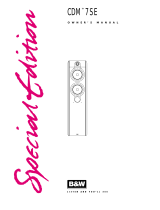 Bowers & Wilkins CDM 7 Manual de usuario
Bowers & Wilkins CDM 7 Manual de usuario
-
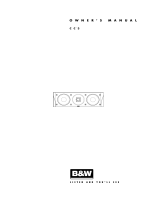 Bowers & Wilkins CC3 Manual de usuario
Bowers & Wilkins CC3 Manual de usuario
-
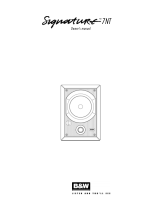 Bowers & Wilkins Sig7-NT Manual de usuario
Bowers & Wilkins Sig7-NT Manual de usuario
-
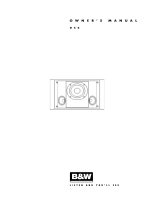 Bowers & Wilkins DS6 El manual del propietario
Bowers & Wilkins DS6 El manual del propietario
-
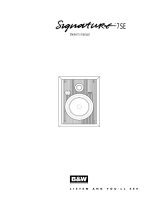 Bowers & Wilkins Signature 7SE Manual de usuario
Bowers & Wilkins Signature 7SE Manual de usuario
-
B&W CCM 636 El manual del propietario
-
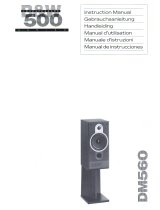 Bowers & Wilkins DM 560 El manual del propietario
Bowers & Wilkins DM 560 El manual del propietario
-
Cognex DataMan 300 Series Guía de instalación
-
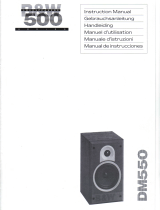 Bowers & Wilkins DM 550 El manual del propietario
Bowers & Wilkins DM 550 El manual del propietario





















